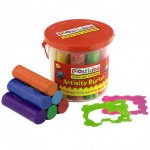Idea from: Sarah Gadd (Head of History)
Who it is for:
This is for anyone trying to encourage students to consolidate and demonstrate their understanding in a different way. I have used this with KS4 and KS5 students and it is useful for AFL work, or teacher assessment of students’ learning.
Outline of issue:
I was teaching about a difficult period of History and with a quiet class. They were able students but struggled with organising their thinking of the role of causes influencing an outcome. The nature of the period I was teaching was not entirely ‘illuminating’ and so I was trying to think of a fun way to assess their understanding and enable students to consolidate their causal thinking.
Idea:
I introduced plasticine! The students used the different colours to illustrate their understanding of the role of factors influencing an event. They worked in pairs to design shapes that represented the role of these factors, how they related to one another, and their relative importance in leading to the outcome. It was for helping to understand the depth of individuals’ causal understanding, their reasoning behind their shapes and patterns and how they had arranged them on the desk. Before presenting, others had to examine the designs and try to figure out what the pair were trying to present. Whilst presenting, other members of the class could ask questions about the reasoning behind their models.
Next steps:
This was preparation for an essay and so enabled discussion in preparation for the planning phase. However, the students could have re-modelled their ideas, they could have labelled their models with specific factual detail and written an account to display below a picture of their model. I did trial cross-presenting to my other class and this worked well in terms of creating competition between the classes.